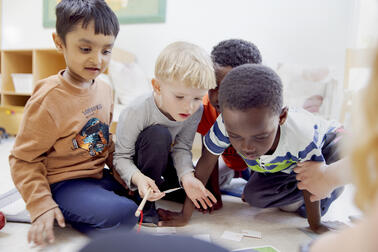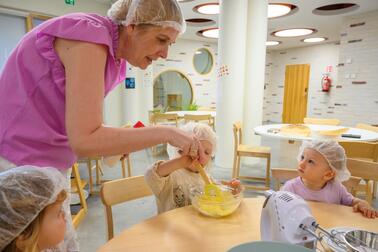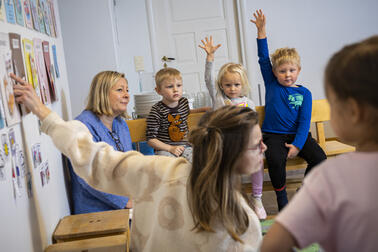Whether eating or playing, the daily routines at the daycare centre are based on solid pedagogy.
Early childhood education teacher Lauri Kalpio and the children spread a grey blanket in the yard of the daycare centre. There it is: a tabula rasa, where you can place cones and sticks to create art. The quickest one checks the yard for any apples fallen from the tree that also might be utilised.
We are in the Roihuvuori district of Helsinki, in the yard of Daycare Porolahti. The warm summer days continue, and the children know how to make the most of them.
Early childhood education teacher Lauri Kalpio has spread a blanket in the yard. Urho, Linnea, and Joakim are artists today.
There is a lot of playing going on. The daycare centre manager, Sannalinnea Hietanoro, says that play and joy are at the top of the list every year when the staff meet in the autumn to discuss the operation plan and its main themes.
In the evening, when parents ask their children what they did in the daycare today, the answers often include playing.
However, it is not ‘just’ playing but also solid pedagogy. Professionals guide what and how the children play: toy cars are now and then put aside and replaced with building blocks – or with pine cones and other objects found outside in nature.
– The children learn life and life skills by playing all sorts of games, says Hietanoro.
She agrees with the old words of wisdom that a significant portion of what we learn during life, we learn at daycare.
Emotional education and friendship skills
Everyday life in daycare includes familiar routines supporting the child’s growth and development.
In the morning, the children are welcomed in person by their first names. Hietanoro emphasises that this is a very special and sensitive moment.
The groups work in pairs, and the staff of both groups also get to know the children in the other group. Adults are here for all the children.
Emotional skills develop in interaction with others. They are practised throughout the day. Mealtimes are a good time and place to express feelings and have a conversation: What do you think the food tastes like? Is it so good you would like to have some more? If you don’t like it, what might be the reason for that? Does it taste bitter, or do you have a tummy ache?
Considering others and friendship skills are essential in emotional education. At its best, daycare centre may be the place where life-long friendships begin.
Early childhood education also supports the development of a healthy self-esteem to ensure that children feel good and accepted as they are. They learn that everything will be all right even if they did not learn something at the first try. Skills are developed by trying things and practising together.
Daily routines also include a peaceful resting moment after the meal. It provides energy for the afternoon. During the hour-or-so rest period, some of the children fall asleep. Others, especially the older ones, may prefer reading a book.
Urho shows what a fine piece art a pine cone is.
The art piece that Linnea, Joakim and Urho made together is almost done.
A big daycare centre needs a lot of staff
The Porolahti early childhood education unit is big. It also includes a smaller daycare centre operating in the Tammisalo community building. The unit has two pre-primary education groups operating with Porolahti Comprehensive School. Pre-primary education means the year after daycare to ensure a smooth transition to school.
However, Porolahti does not feel like a big daycare centre, for which Hietanoro thanks the smart construction practices in the 1970s.
Daycare Porolahti has approximately 50 staff members, and in addition to Hietanoro, the daycare centre has a deputy manager and a special needs teacher to support the teams and to provide pedagogical expertise.
The daycare centre has a long tradition in special needs education. An integrated group, including children with special needs, was recently divided into two. Hietanoro has noticed that it was a good solution, enabling the children in need of special support to be supported better.
Additional housing is planned and built in the Roihuvuori district. New families with children have moved to the area, and more will come.
The situation in Porolahti is the same as elsewhere in Helsinki and the whole country: the daycare centre needs more professionals.
– It is not that we do not have the funds to hire people; there just are not enough of them on the labour market.
The state supports municipalities and cities. Helsinki also has received additional funding for early childhood education and could employ, for example, additional temporary trainees who are not required to have qualifications in the field.
Hietanoro thinks that training could be ideal for a young person who is thinking about applying to the field. However, they cannot replace professionals.
The tight staffing situation is highlighted when substitutes are needed in the daycare centre. If the need for a substitute is known in advance, such as in the case of a parental leave, the process of finding a suitable person starts immediately.
Even though Daycare Porolahti is a big daycare centre, it feels homely.
Diverse and rich work
Hietanoro finds it regrettable that only bad things usually come to public attention: the daycare centres could share good news on a daily basis.
Let’s take coping as an example. Not all professionals are exhausted from work. On the contrary, there are professionals in Porolahti who have had a long career and have been enthusiastic about their work and the children right up until their retirement. The current staff include people in their 60s.
– The work is very in-the-moment, diverse and rich. Personally, I think this is the best job in the world, Hietanoro says.
According to Sannalinnea Hietanoro, the best job in the world is at a daycare centre.
Daycare Porolahti
The unit includes 270 early childhood education and pre-primary education places. The Daycare Porolahti building has 180 early childhood education places.
The building is on two floors and has separate facilities for each group. The small group rooms have their own idyllic atmosphere.
The large courtyard is divided into three parts with a separate area for the smallest children. The parks in the neighbourhood provide a feeling of space, and the Kirsikkapuisto cherry blossom park on the Western side is a particular favourite in the springtime.
Original text in Finnish: Kirsi Riipinen
Photos: Lauri Oja


